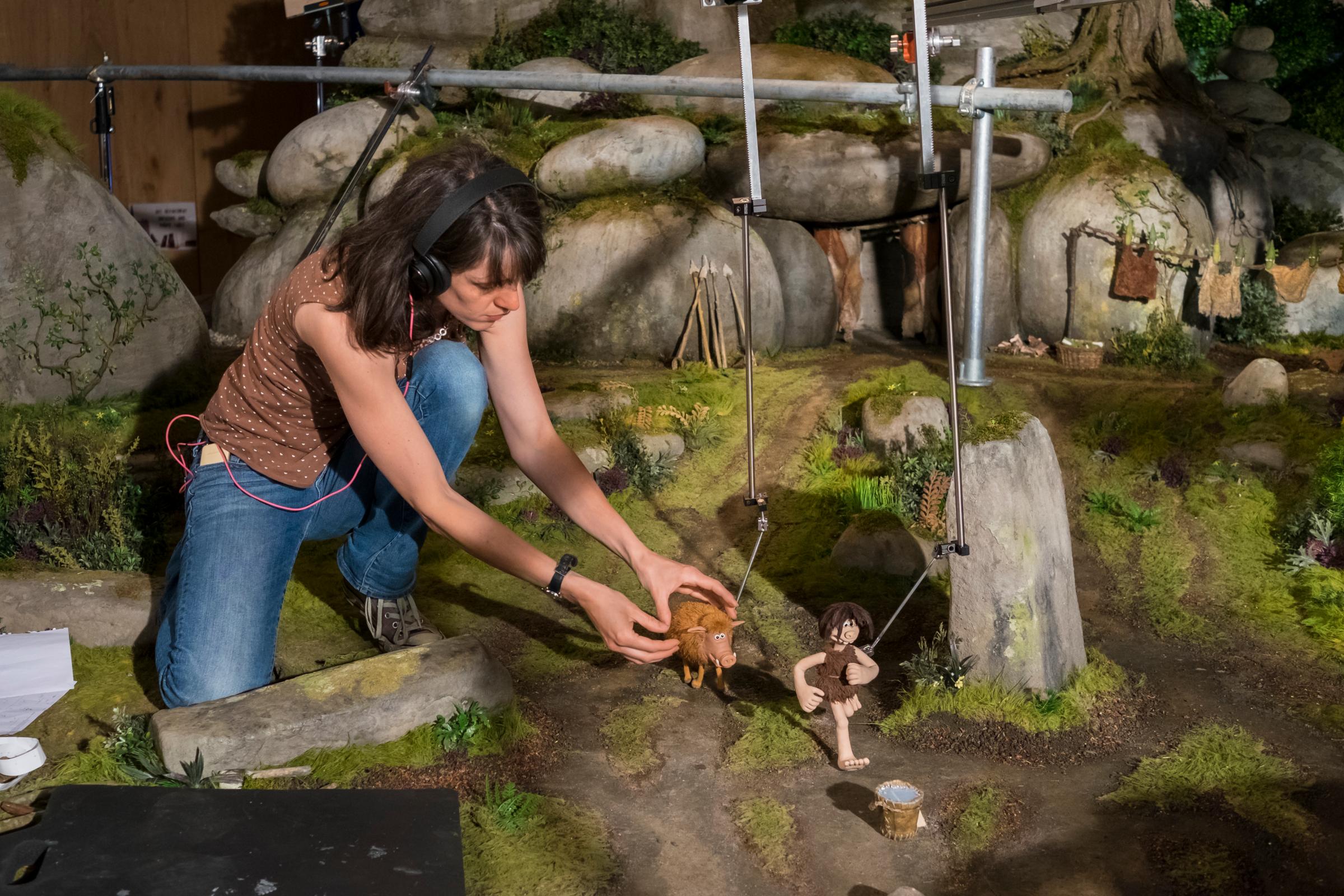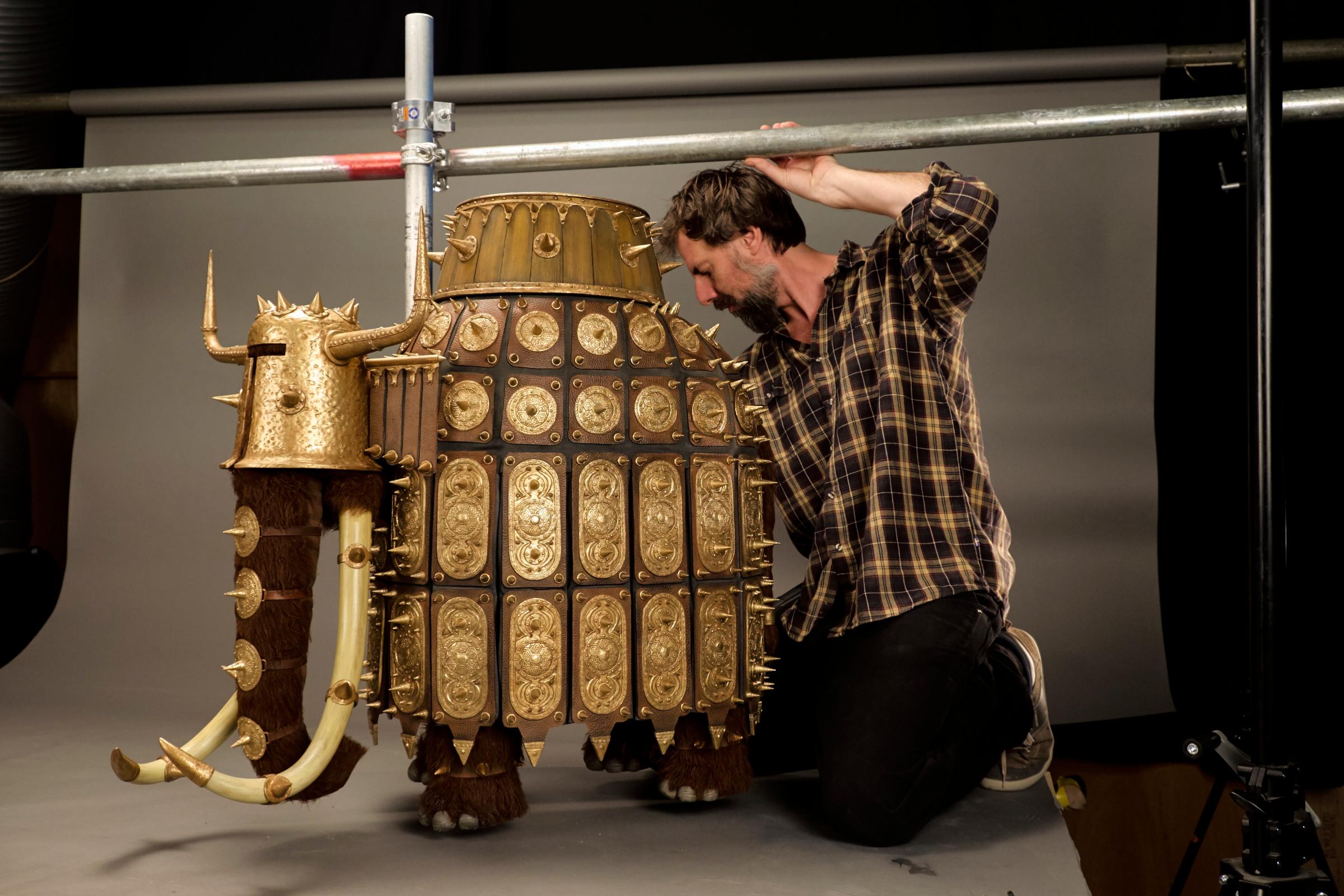It’s 10 a.m. in an enormous studio in Bristol, England. For hours, a film crew has been adjusting lights and setting up cameras for the morning’s shoot. The stars of today’s scene are waiting off set, their intricate costumes receiving last-minute touch-ups, their stunt doubles ready.
Action time. The camera begins its journey down a railway-like structure, capturing the scene frame by frame. There’s silence on set. Then disaster strikes.
The ear of the leading lady has fallen straight off, landing on the set’s wooden floor with a soft “phut.” An assistant rushes over and the cameraman curses, knowing he’ll need to reshoot the scene. Everyone’s wondering the same thing: how easy will it be to reattach the organ?
Despite the chaos, there’s no blood. No ambulance is called, no movie contracts studiously examined. Why? Because the star of this scene is a clay puppet, whose movements are animated in meticulous detail by a team of professionals at Aardman Studios. Aardman is the home of stop-motion animation, also known as “claymation,” and the studio is best known for the creation of Wallace and Gromit, an eccentric inventor and his intelligent dog who, in the 1990s, became some of England’s most beloved characters.
Ahead of the release of the Aardman’s seventh feature film, Early Man, TIME visited their studio in Bristol. The family-friendly adventure comedy, which stars Eddie Redmayne, Tom Hiddleston and Game of Thrones’ Maisie Williams and hits U.S. screens on Feb. 16, continues the studio’s long tradition of prioritizing a lovingly handmade feel even as the rest of the world goes digital.
Aardman’s origins: From a teenage hobby to the Oscars
Schoolmates Peter Lord and David Sproxton began animating together as a hobby when they were teenagers, using a 16mm clockwork Cine Camera belonging to Sproxton’s father, an amateur photographer and a producer at the BBC. The pair played around with cut-outs from magazine color supplements and chalk drawings, spending weeks making fun one-minute clips.
“Through pure nepotism,” according to Sproxton, their first work came with Vision On, a BBC show for children who were deaf or hard of hearing that ran from 1964 to 1976. Aardman Animations, named after an early character, was registered as a company in 1972, and the pair moved to Bristol around four years later.
Lord and Sproxton worked steadily, earning recognition for their creation of the shape-shifting Morph, in 1977, who would become even more famous two decades later when he was included in the children’s program Take Hart. They received their first Academy Award in 1990 for Creature Comforts (1989). In the short film, directed by Nick Park, the voices of real members of the British public play out of the mouths of plasticine zoo creatures, to great comedic effect.
Nick Park joins the team, bringing Wallace and Gromit
In 1985, four years before Creature Comforts, Lord and Sproxton joined forces with Nick Park, a talented animator and graduate of the prestigious National Film and Television School.
Park had invited the pair to give a lecture at his college. At the time, he was working on his graduate project, A Grand Day Out, starring Wallace and Gromit. The now iconic duo looked a bit different then: Gromit was initially a cat — until Park realized that a dog was far simpler to animate. (The plasticine limbs could be longer and fatter, making it easier to walk it.)

Lord and Sproxton recruited Park to help out with Morph, eventually offering him a full-time job. As a trio, they followed up on Park’s original Wallace and Gromit film with four successful shorts starring the duo, and an Oscar-winning movie, 2005’s Wallace & Gromit: The Curse of the Were-Rabbit. But the studio wasn’t just making films. Aardman brought its signature style to music videos, from the Spice Girls’ “Viva Forever” to Nina Simone’s recording of “My Baby Just Cares for Me.” Their advertising partnerships with brands included McDonald’s, the bubble gum brand Hubba Bubba and Chevron.
Aardman went on to make several critically-acclaimed features. The Great Escape-inspired Chicken Run, a collaboration with the U.S. animation studio DreamWorks which grossed nearly $225 million worldwide, making it the most successful stop-motion movie of all time. But the studio’s foray away from its stop-motion roots and into CGI in 2006, with Flushed Away, was a misstep. A commercial failure, it marked the end of the company’s partnership with DreamWorks. Soon after, Aardman returned to its original Claymation formula.
The painstaking labor behind Early Man
Aardman’s latest outing, Early Man, is an underdog sports story set in prehistoric times, based on the (not so historically accurate) idea that cavemen invented soccer. Park had been nursing the idea for years. “What if lovable idiot cavemen had to stop using their weapons and fists and play a disciplined game?” he explains. “With sport, you still have the tribal aspects of ‘us against them,’ but the aggression is all channelled through a sport — it’s a real civilizing force.”
Creating “Braveheart with balls,” as he describes it, was no easy feat. The story is set in multiple locations including a lush green valley forest, badlands with prehistoric volcanoes and a city made of bronze. This meant roughly 40 sets were on the go at any given time, flanked by a crew exceeding 150. Animators were expected to achieve two to three seconds of footage per day, meaning a minute-long scene could take weeks to shoot.

But for Park, the single biggest challenge was executing a stop-motion soccer match that was cinematic and exciting. “I was inspired by films like Gladiator,” he says. “I wanted to channel the atmosphere and roar of the crowd and the way the camera is used.” For the stadium scene, the team built a soccer field the size of a room. The lower ranks of the stadium was built physically, but the rest of it, as well as the crowd, were later added with CGI.
There was also concern about the fur fabric costumes worn by the cavemen. Generally, the puppets are readjusted by the animators around 12 times per second, which means they are constantly being touched. As a result, certain fabrics, like fur, have a tendency to change shape. Fur that’s animated frame by frame can often end up looking as though it is twitching, known in the animation world as “boiling.”
But this did not worry Park. “I could see the animators’ look of horror when they realized they had all this fur fabric and hair to animate,” he says. “But personally I like the twitchiness, in the same way that I like to see the animators’ fingerprints in the clay. Often I would encourage the animators to be rougher; we don’t want the film to look too smooth or too slick so the audience is reminded of the craft and the handmade-ness of it.”
Claymation’s enduring appeal
A lot has changed at Aardman since the 1970s. Far more materials are now used in puppet creation. While the earliest versions of Morph were made of solid clay and plasticine, the majority of today’s creatures are molded around solid metal armature, making them considerably more robust. Then there’s the advent of 3D printers, which Aardman has used to make everything from props to pirate mouths.

The world of animation is also a different place. Forty years ago, Aardman was groundbreaking in its use of stop-motion technology. But these days, it’s not the only company favoring puppets. Laika, a production company in Portland, Oregon, and Aardman’s biggest rival, was nominated for an Oscar in 2009 for Coraline, and another in 2017 for Kubo and the Two Strings. 3 Mills studio in East London recently finished production on the Wes Anderson-directed stop-motion animation film Isle of Dogs, out March 23. And the French stop-motion production My Life as a Courgette (also known as My Life as a Zucchini) won the Best Animated Feature Film at the 2016 European Film Awards.
But Aardman’s fundamental craft remains relatively unchanged. Aside from dabbling in CGI for Flushed Away, the studio hasn’t strayed from the painstakingly slow stop-motion tradition that propelled it to fame in the 1980s. “You can work wonders with CGI and do some fantastic stuff with it, but it can feel a little bit emotionally cold,” says Sproxton.
“Stop-motion animation is like a brilliant magic trick, and part of the fun of a magic trick is you know it’s not magic, but you have no idea how it actually worked,” says Lord. “You believe in the characters, even though a part of your brain is telling you they’re just made from clay and wool. I think that’s magical.”
Correction: The original version of this story misstated the year the character Morph was created. He was introduced in 1977, not 1997. It also misstated the year of release of Wallace & Gromit: The Curse of the Were-Rabbit and the number of Wallace and Gromit short films. The movie was released in 2005, not 2006, and there were four short films, not six.
More Must-Reads from TIME
- Cybersecurity Experts Are Sounding the Alarm on DOGE
- Meet the 2025 Women of the Year
- The Harsh Truth About Disability Inclusion
- Why Do More Young Adults Have Cancer?
- Colman Domingo Leads With Radical Love
- How to Get Better at Doing Things Alone
- Michelle Zauner Stares Down the Darkness
Write to Kate Samuelson / Bristol at kate.samuelson@time.com